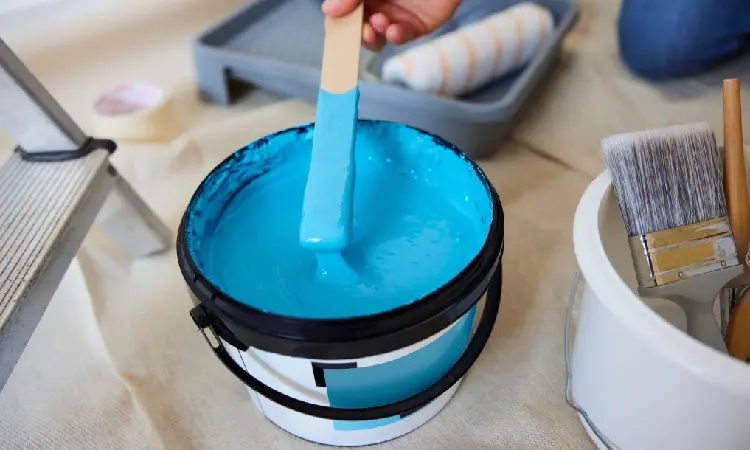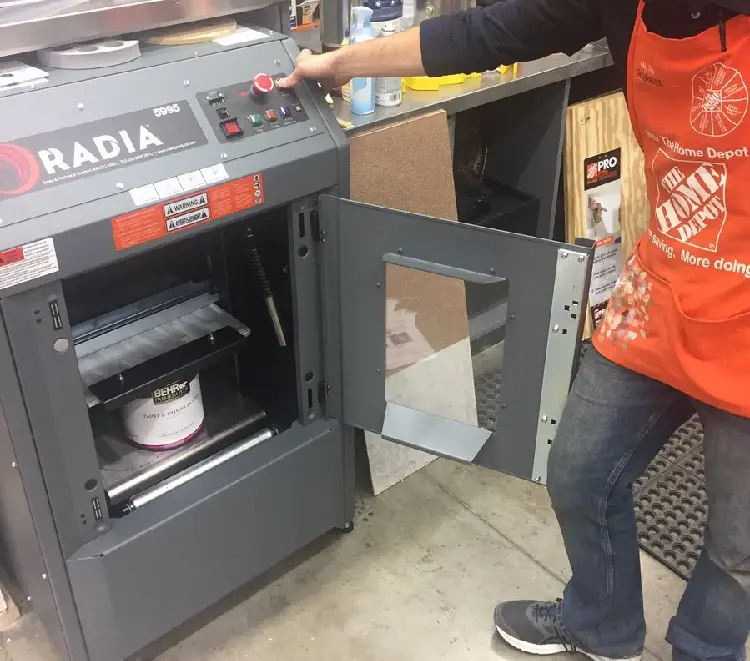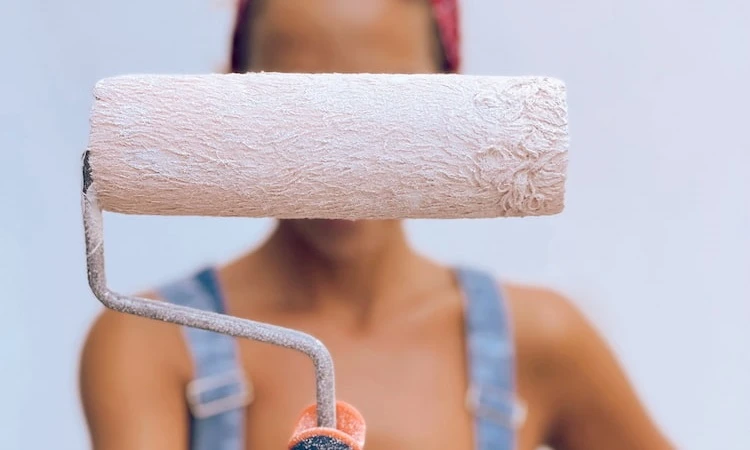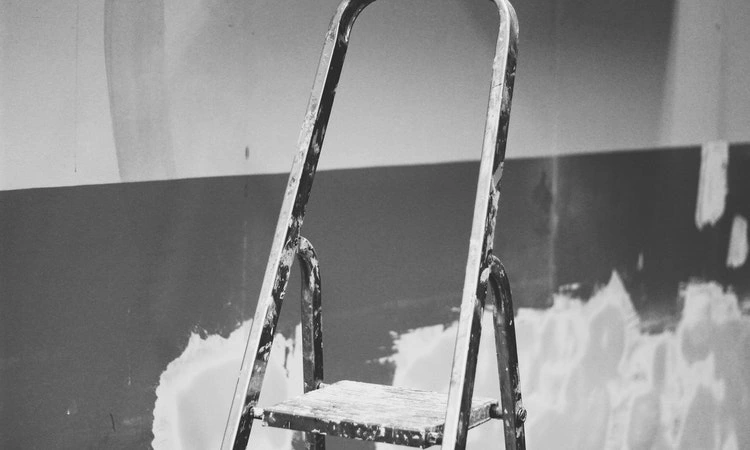Are you a homeowner who paints their house on occasion? Or, how about a professional painter that paints homes day in and day out?
You’ve come to the right place if you answered yes to either of those questions.
I’m here today to discuss paint stirring and shaking. It is in your best interest to do one or the other before you begin to roll, brush, or spray colors onto a surface. But why? That’s the million-dollar question.
Sure, people are told how important it is to mix paints before applying them. However, it isn’t always made clear why they should do that, and that is what I’m here to answer today.
So, is that something that piques your interest? If that’s the case, don’t go anywhere. Instead, stick around and read through the following sections to learn more.

Shaking vs. Stirring Paint: Overview
| Shaking | Stirring | |
|---|---|---|
| Why? | When paint sits for a while, its components separate and shaking helps the components come together | When paint sits for a while, its components separate and stirring helps the components come together |
| When? | When you purchase a new paint from a store and before each use | Every time you open a can |
| How? | Paint stores normally shake your newly purchased paint for you | By stirring an opened can of paint in a clockwise or counterclockwise motion with a stick or by drilling it with a paint stirrer |
| How long before shaking/stirring again? | 24 to 48-hours | Recommended to stir paint every time you open a can |
Why Do You Need To Shake Paint?
Solids and liquids are used to create paints, and the ingredients don’t stay together. Rather, when cans or bottles remain unused and unopened for a while, the parts separate.
That’s why when people first pop container lids, it isn’t uncommon for them to see oils floating on the top.
Shaking helps these things come together so that paints are ready to use. If you apply a coat before it is mixed well, don’t be surprised if it doesn’t look the same as the color on the can.
It may also not match an existing shade on a wall, ceiling, or another surface.
I will now break it down differently, just in case you still don’t get it. Think of paints as two parts, pigments and mediums.
Pigments are typically small ground particles that provide color. They can be loads of different items, including but not limited to clays, dyes, etc.
Meanwhile, mediums are clear more often than not. After being subjected to the air and allowed to cure, these substances give paints their textures, and the colors created by the pigments are locked in.
When house paints sit, even if for only a day, heavier pigments sink to the bottom of cans, shaking the paint container gets everything back in order.
It’s like a factory reset. However, people often stir paints before using them, as shaking is often reserved for the places where the products are sold.
Will Paint Stores Shake Your Paint For Free?
When you purchase new paint cans from a store, there’s a good chance that a worker will put them on a machine that shakes them for free.
For instance, Lowe’s and Home Depot both offer this service.

However, you probably shouldn’t simply show up to a location with a paint container and expect someone to shake it for no charge.
That likely won’t happen. Some companies will not do the deed at all.
Then, others charge fees for shaking paint not purchased through them. Hence, do yourself a favor and call your local store beforehand.
The last thing you need is to get caught off guard by a surprise expense or not get your paint shaken at all.
How And How Long Do You Shake Paint At Home?
Most homeowners do not own paint-shaking machines. Thus, it isn’t like they can just hook containers up and let the devices do their things.
Instead, those that want to shake paint must take a manual labor approach to the venture.
First, ensure the can’s lid is on nice and tight. Cover the top with a cloth and use a hammer to tap around its edge.
Next, hold the container upright in both hands.
Then, turn it upside-down. You are going to want to repeat these steps repeatedly for several minutes.
In addition, you can shake the receptacle vigorously from side to side if you wish. Just be aware that if shaking is the way you decide to go, your arms could get a bit tired in a hurry.
However, that is a small price to pay for the right mixture and perfect color for your house.
FYI, shaking typically isn’t done with brand-new products, unless it’s completed by professionals.
With full cans, there simply isn’t enough room for ingredients to move around and mix via manual labor. Therefore, you’ll probably need an alternative way to blend items.
Stirring can be the perfect solution, and I’ll talk about that here shortly, but there is another topic to cover before getting to that one.
How Long Before Shaken Paint Needs To Be Shaken Again?
It depends on who you ask, but most research points to one thing. Paint that is shaken normally remains mixed for about a day or so.
That means if you purchase a can from a store that shakes it, you’ll probably be able to use it as-is for 24 to 48-hours before it needs to be shaken again.
However, if you took a DIY approach to the shaking, you may have to shake or stir the solution before each use. That is because people simply cannot shake containers as well as machines.
So, keep these tidbits in mind. House paint needs to be mixed thoroughly. If yours isn’t, you surely won’t appreciate how it looks on the siding, trim, or whatever at your place.
Why Do You Need To Stir Paint?
Paint doesn’t necessarily have to be mixed via shaking. Many people choose to stir the solution to get the ingredients to blend. As discussed earlier, when paint sits, its components can separate.
The same can sometimes be said for when extreme temperatures enter the picture.
Therefore, people stir paints to get pigments and mediums to become one and transform into the vivid colors they crave.
This option can be easier on the arms than shaking.
All needed to complete the task is a paint stirrer, which can be acquired from a paint or hardware store.
Sometimes, companies provide the sticks to consumers who buy paint from them.
However, people can also purchase the units separately if need be.
The point is if you’re going to be painting the inside or outside of a house soon, you’ll want to be sure to have paint stirrers on hand.
What Happens if You Don’t Stir Paint Enough?
When you don’t stir paint long enough, the pigments and mediums don’t mix.
Then, when a coat is applied to a painted surface, the color won’t match. Stirring also smooths clumps and removes bubbles from paint.
When people fail to stir latex, semi-gloss, and other paints, the texture they’re left with in the end could be uneven and unappealing.
So, take the time to get it right the first go-around by stirring enough in the first place.
Then, you’ll get more coverage out of every can of house paint that you use, and that could save you some cash by not having to buy multiple containers for sections when only one will do.
How And How Long Do You Stir Paint?
Stirring paint isn’t a challenging task.
However, there are multiple ways to accomplish the feat, and some of the ways are easier and less time-consuming than others.
Stirring by hand
Firstly, if you’re only stirring a pint, quart, or gallon of paint, all you should need is a plastic or wooden mixer paddle.
To begin, you’ll have to open the can of paint with a paint can opener or flathead screwdriver.
Next, grab the mixer paddle and stick it down into the bottom of the container while holding onto the end.
Now, move the stick in a clockwise or counterclockwise motion, whichever you are more comfortable with. Stir around the outside and middle of the can for approximately two to three minutes.
That is an ample amount of time to get all of the components mixed and blended.
Then, you can apply the paint to your home.
Stirring with a drill
Would you rather work smarter instead of harder and take the work out of paint stirring? Nobody would blame you if you said yes.
To pull that off, a drill with a paint stirrer bit will be required. Be sure to get the right size, depending on what you’re trying to stir.
For example, a long bit and large drill might be necessary for a 5-gallon bucket of paint. Meanwhile, a smaller bit and drill will be essential for a gallon or less of paint.
Even with a drill, you should stir paints for two to three minutes.
That will be easy enough, though, as the tool will take care of all the spinning and mixing. Just be careful when utilizing this method. Take everything nice and slow so that paint doesn’t splash everywhere.
The last thing you need is to waste those precious drops with the inflation that it is today. After all, everything seems to cost an arm and a leg, including painting and building products.
Plus, who wants to clean up a giant mess anyway? That can be challenging with the substance smearing about.
How Long Before Stirred Paint Needs To Be Stirred Again?
If stirring by hand, stir the paint between 30 and 40 times.
As far as when stirred paint will need to be stirred again, that can depend on various factors like brand, storage length, and ingredients.
However, it is a best practice to stir paint every time you open a can.
The only time you don’t really have to worry about stirring is when you bring paint home from the store immediately after it has been shaken.
It will be ready to use directly, and it may not need to be shaken or stirred for around a day or so.
FAQs: Shaking vs. Stirring Paint
1. Should paint be shaken or stirred?
It is up to the painter to determine whether they want to shake or stir paint.
Each method should be done for approximately two to three minutes. If you already have a drill and mixer paddle, those items can make your life easier.
However, if the tools need to be purchased, that will increase your initial costs. Weight the pros and cons of the different styles to decide which one is appropriate for you.
2. What does paint stirring do?
Paint cans need to be stirred after they have been sitting for a period. How often products must be stirred will vary.
However, it is normally a good idea to stir house paint before each use. The action will ensure that all ingredients are blended and there won’t be clumps or bubbles in the solution.
The pigments and mediums will also get mixed to create a vivid shade.
3. What happens if you don’t shake or stir paint?
When paint ingredients separate, and a person does nothing before applying a coat to a door, wall, or something else, that can be disastrous.
After painting these surfaces, the individual will likely notice that the color doesn’t match what is already in place. Not only that, but holidays might appear.
In painting, a holiday is a missed spot. When the paint isn’t mixed or stirred, it often goes on unevenly. Thus, holidays are born.
Additionally, no stirring/shaking sometimes equals clumps and lumps. Hence, people who fail to tackle these things initially can be left with textures they don’t care for.
4. When should you stir paint?
The answer to this question could vary, depending on who you ask. However, a person can’t go wrong in stirring every time they open a can or bucket of paint.
That will get oils, pigments, mediums, and whatnot mixed, creating the colors and textures they desire.
Then, the paint won’t streak or leave holidays on surfaces. In turn, you’ll be happy with your finished projects. Stir paint after it has been sitting and before you apply it to anything.
The only time that really may not be necessary is when you’re bringing a container of paint home that’s just been shaken at a paint store.
Immediately after this happens, and maybe even for a day or so later, the paint should be ready for walls, trim, etc.
5. Do you need to stir paint that was just mixed?
Do you need to stir paint that was just mixed? That depends on when that mixing took place. Just is a word that doesn’t mean the same thing to everyone.
For example, as far as this scenario is concerned, the paint could have been blended over a week ago. Then again, it just might mean that it happened 20-minutes ago. I am speaking of the latter here.
It has been reiterated throughout this post that paint does not need to be stirred directly after it has been shaken. So, you don’t need to stir paint that was just mixed.
Instead, simply pop the lid and use your brush to get some out of the can.
But, of course, it isn’t going to hurt anything if you decide to stir the paint right after shaking occurs.
Hence, if it makes you feel better, don’t hesitate to use a paint stirrer or drill and mixer paddle to stir the components, whether the paint was just mixed or not.
6. Do I need to shake the white paint?
Latex, semi-gloss, and other types of paint can and will settle. Therefore, it doesn’t matter what color the solution is, it must be shaken.
At the very least, this must occur as soon as the paint is purchased.
Then, afterward, you can switch to stirring to get all of the parts to blend and become one.
If the paint can have previously been opened and used, you can also use a do-it-yourself shaking approach for the mixing if you wish.
Refer back to the “How And How Long Do You Shake Paint At Home” section for a refresher if you need it. Just be sure to stir or shake the white paint.
The activities will make the substance smooth, where it will apply to surfaces evenly.
7. What if you shake your paint too long?
Paint can’t be shaken or stirred too much. The tasks remove lumps and clumps. They also make pigments and mediums mix thoroughly. So, don’t be afraid that you’re going to shake or stir too long.
However, as a rule of thumb, it should only take approximately two to three minutes to complete the stirring or shaking with new paint cans.
Meanwhile, if the paint in question is old and has been sitting for a while, you will likely need to stir or shake it a bit longer to get everything in order.
8. Does Primer Need To Be Shaken?
Primer goes on surfaces ahead of paint. It is thick to fill small holes, cracks, and blemishes.
Plus, primer is formulated with a stronger binder than typical house paints. Thus, the pigment and medium might not separate.
The research is split on what to do when it comes to primer. Some believe nothing needs to happen, and the substance is ready to use straight out of the can.
Meanwhile, others think you should always stir/shake all paints, including primers, to ensure they’re blended.
Hence, use your discretion when it comes to this task. Do some research online and ask your local paint store representative what he or she recommends.
That should provide you with the data you need to decide whether to shake primer or not.
The Final Verdict
To shake or stir the paint, that is the question. There isn’t necessarily a right or wrong answer here. You must decide which solution, stirring or shaking, is appropriate for you.
If you can get a paint store to shake your paint, that is the easiest route. These firms have machines that shake paint cans. They make mixing the internal ingredients a breeze.
But people can also shake paint at home if they like.
The process is relatively simple, but it might wear their arms and shoulders out, even though it only needs to be done for two to three minutes.
Stirring is usually just as easy, though. It too should last for two to three minutes, and most paint stores provide consumers with wooden paddle mixers so they don’t have to buy anything else to blend their paint.



